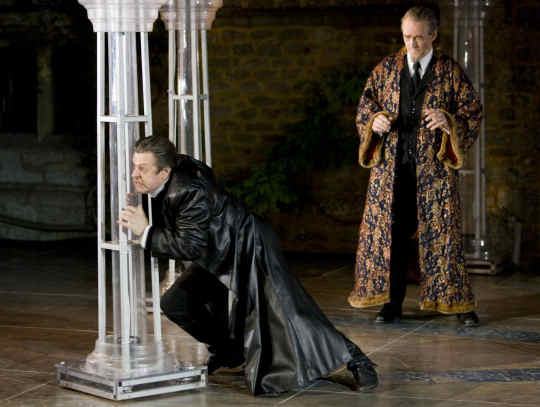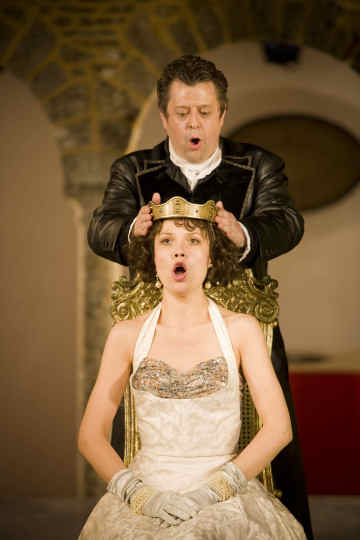Other Links
Editorial Board
- Editor - Bill Kenny
- London Editor-Melanie Eskenazi
- Founder - Len Mullenger
Google Site Search
SEEN
AND HEARD OPERA REVIEW
Garsington
Opera (2): Vivaldi, L’incoronazione di Dario.
Soloists,
Garsington Opera Orchestra, Laurence
Cummings (conductor) Garsington Manor, Garsington, Oxfordshire,
England. 25. 6.2008 (AO)
Garsington Manor overlooks the Oxfordshire countryside. Architects
call this “borrowed landscape” where vistas extend beyond a
property, into the distance. Garsington Opera productions follow
the same principle. The stage is literally built on the terrace
that connects the house to the flower gardens. The performance space
is open on one side. Sometimes rain and wind intrude on a
performance – as do birds – but that is part of the pleasure. This
is opera which blends theatre and reality, art and nature, and gives
Garsington its special charm. This charm is now tinged with
melancholy, for productions will only be held here until 2011.
Garsington Opera needs a new home. Whatever happens, though, it has
developed a distinctive character which will adapt well to new
challenges. Its founder, the late Leonard Ingrams, knew that
chamber operas and rarities are heard to advantage in intimate
settings like these. One of the glories of the English summer is
“country house opera”, and Garsington is its embodiment.
Musically, L’incoronazione di Dario also seems like a mix of
standard formulae. In this new critical edition, the arias and
recitatives are fairly short and undeveloped. Ideas flash past and
aren’t extended as in more sophisticated work. The orchestra has its
moments. When the two theorbos (large and small) play together,
they underline the vocal duets, and the violins have many
interesting passages, but altogether, there’s no particular
structure orchestrally to detract from the lively action. It was a
pity, because this orchestra was very good. They are musicians
trained to 20th century standards, playing what might
have been performed by basic theatre players 300 years ago. But to
their credit, they appreciated that this music works better when
it’s played with the vigour and energy it received here.
Paul Nilon : Dario
Renata Pokupič : Statira
Wendy Dawn Thompson : Argene
Russell Smythe : Niceno
Sophie Bevan : Alinda
Nicolas Watts : Oronte
Katherine Manley : Arpago
Antonia Sotgiu : Flora
David Freeman : director
Dan Potra : designer

Dario (Paul Nilon) and Niceno (Russell Smythe)
Leonard Ingrams also understood the value of extending repertoire,
so he would have been delighted that this year, Garsington has
brought Vivaldi’s L’incoronazione di Dario to Britain for the
first time. Vivaldi has benefited from the upsurge of interest in
the baroque, and his music is still being unearthed. There was a
big demand for music theatre in Vivaldi’s time, and he may have
written as many as 100 operas to satisfy the market.
L’incoronazione di Dario was first performed as part of the
Venetian Carnival in 1717. It’s an energetic romp, set in ancient
Persia, or rather what early 18th century Venetians took
for Persia. This gives an exotic frisson to what is basically
standard mistaken identity farce. Whoever marries the princess
Statira will inherit the empire, so she has three suitors, Dario,
Oronte and Arpago. Each is early defined so the Carnival audience
can tell them apart. Dario is the straight man, and hero, while
Arpago, the warrior general, would probably have been sung by a
castrato or countertenor. Dario uses Argene, Statira’s sister, to
convince Statira to marry him, but she falls in love with him, so
she plots to kill her sister and grab Dario and the throne. Of
course, there’s a sub plot involving servants : Statira’s tutor
Niceno is secretly in love with her too, and the maid, Flora is
pivotal to the action. It’s pretty much standard fare, the main
twists being that all is not righted at the end. Argene and Niceno
aren’t saved by some bizarre dramatic device, they are just
“disappeared”. This isn’t the carefully crafted harmony of Così
fan tutte, though I suspect that it isn’t deliberately dark, but
rather unpolished, perhaps because Vivaldi wrote almost 100 of these
operas.

Dario (Paul Nilon) and Statira (Renata Pokupič)
In many ways, L’incoronazione di Dario is more of a play than
an opera, as the vocal demands aren’t great and there aren’t many
star turns. So if the singing was more enthusiastic than polished,
it was no problem. Wendy Dawn Thompson as Argene was excellent :
she’s a natural character actress, and the part is piquant. Paul
Nilon as Dario was also impressive. Good performances, too, from
Renata Pokupič and the rest of the cast.
Fortunately, if L’incoronazione di Dario doesn’t quite
convince as music, this production made it work very well as
theatre. The plot is thin and illogical, so the staging turns its
weaknesses into virtues. A huge half finished “Persian” head hovers
above the stage throughout. It’s the dead King, who interjects
during the course of events. At the end, his huge hand is left
pointing at the stage. It’s hilarious. Argene is a princess right
out of 50’s America, complete with Elvis Presley 45’s, a gingham
crop top and tight jeans. Why, one might ask ? But that’s the whole
point. This isn’t supposed to make sense. Baroque isn’t literal,
and this is entertainment, not philosophy. So when the suitors
fight, it’s cod pantomime. Casting a soprano instead of a
countertenor as Arpago the suitor adds yet another irreverent touch.
He/she wears the kind of military uniform Michael Jackson might take
seriously, for this is the least butch soldier imaginable. So when
he/she sings about being the greatest soldier the kingdom ever had,
it’s parody. This isn’t ancient Persia, whatever the text may
pretend. Even Flora, in Persian dress, comes over with wit.
But perhaps the star was the stage itself. When Statira leaves the
palace and heads for the wild, dangerous forests supposedly
inhabited by beasts, she can be seen parading through the neat
parterres of the flower garden, he wedding dress and train blowing
in the breeze. Dario runs into the garden slashing his sword to
create a bouquet for her. There are lots of real flowers out there,
but he brings in an obvious fake, which she swoons over. He has a
“mad scene” in which he slashes one of the two trees on stage in his
“rage”, but it’s artificial. The other tree is real, or looks like
it is. Just as “borrowed landscape” works in the gardens at
Garsington, borrowed landscape works in its opera productions. It
expands the stage and participates in the drama, without singing,
without music, but very much part of the action. The actual
configuration of terrace and garden may change when Garsington
moves, but the imagination and intelligence that it has inspired
will live on.
Pictures © Johan
Persson
Back to Top Cumulative Index Page
